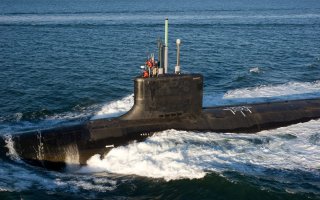Why Use Nuclear Submarines When Regular Diesel Subs Can Get the Job Done?
Conventional boats are better fitted for shallow-water operations.
Want to add much-needed mass to the fleet at an affordable cost, in relatively short order, at minimal risk? Conventional subs sound like a compelling way to do it. Now, nuclear proponents have a standard riposte to proposals for a diesel revival, touting nuclear-powered boats’ staying power at sea, long cruising range, and the like. All true, but irrelevant for the missions at which diesel boats excel. U.S. Navy and Marine Corps strategy increasingly calls for procuring winsome, cheap, yet hard-hitting warships in large numbers in order to prosecute “distributed” operations. The concept would add resiliency to the fleet, letting it absorb the loss of individual ships while retaining enough capacity to fight on. That applies to the undersea fleet as well—or should.
Manned and unmanned conventional submersibles appear to fit neatly into the new paradigm.
Furthermore, consider the strategic environment where the sea services expect to do battle. If the antagonist is China, and if naval commanders want to blockade China’s navy and mercantile fleet in home waters, the logical battleground is the waters along Asia’s first island chain. Block the straits between the islands and you imprison Chinese shipping within the China seas, doing the adversary a world of hurt in not just the military but the economic sphere. It doesn’t take a Seawolf-like submarine that sorties thousands of miles from home to seal off a narrow sea. A diesel sub stationed in the theater—at, say, Sasebo or Yokosuka, home to the U.S. Seventh Fleet—can reach its operating grounds and loiter there, sinking ships without all the excess capability manifest in an SSN. And in fact, conventional boats are smaller than their nuclear brethren and thus better fitted for shallow-water operations along the island chain. They go where nuclear-propelled behemoths dare not.
History has vindicated this approach. Japanese submariners practiced island-warfare tactics throughout the Cold War, executing their duties with aplomb. They continue to do so today as the JMSDF submarine force grows. Adding a U.S. Navy contingent to the effort would only reinforce the island-chain barrier. It would improve the odds of holding the line while letting SSNs play linebacker in the Western Pacific, flitting around behind the line and assailing anything that sneaks or breaks through the barrier. That sort of mobile defense across large sea areas would suit the Virginia class and would suit the faster, brawnier SSN(X) even better.
Corbett would smile at seeing submarines—upstart flotilla craft in his day—take their place in the fleet as cruisers and capital ships as well.
Think about it.
James Holmes is J. C. Wylie Chair of Maritime Strategy at the U.S. Naval War College. His books appear on the U.S. Navy, Marine Corps, and Indo-Pacific Command professional reading lists. The views voiced here are his alone.
This article first appeared in November 2020.
Image: U.S. Navy photo courtesy of General Dynamics Electric Boat

